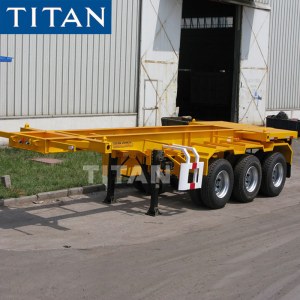Container trailer is specially designed to carry various cargo containers. Container chassis includes 20, 40, 45 foot and other types. It is dedicated to transporting containers. It contains two kinds of skeletal trailer for long distance transportation and terminal trailer for port transportation. What should I do if the skeletal trailer suddenly fails to brake? We should learn more about this common sense and help ourselves at critical moments.
Causes of failure of trailer brakes
1. Lack of necessary maintenance for the brake system, too many impurities in the brake master cylinder, inadequate sealing, failure of the vacuum booster pump, dirty brake fluid or mixed use of several brake fluids, air resistance, brake master cylinder or sub-pump after heating Oil leakage, air storage tank or pipeline interface leakage;
2. Due to improper operation, the machine parts fail;
3. Due to severe overload, under the effect of gravity acceleration, the skeleton trailer's motion inertia is increased, which directly leads to brake failure.
How to deal with brake failure?
1. The skeleton semi trailer should apply the brake regardless of the condition when going down a long slope or a steep slope. Not only can the brake performance be checked, but also the time to control the speed when the brake fails, also known as predictive braking;
2. Control the direction according to the road conditions and the container chassis trailer speed, disengage the high-speed gear, and at the same time slam the air and air at a high speed to change the high-speed gear into the low-speed gear. In this way, there is a large traction resistance at the time of launch and the 40ft container trailer speed is reduced rapidly. In addition, when changing the low gear, the hand brake should be used separately, but it should be noted that the hand brake cannot be tightened or pulled too slowly. If it is pulled too tight, it is easy to make the brake disc "lock", which may damage the transmission mechanism and lose the braking ability; if it is pulled too slowly, the brake disc will wear and ablate and lose the braking effect.
3. The rigid parts of the container chassis such as the bumper, carriage and other natural obstacles (rocks, big trees or earth slopes) are rubbed and collided to achieve the purpose of forcibly stopping the vehicle and reducing the accident losses as much as possible.
4. When the downhill brake fails and the Bomb Trailer's own mechanism cannot be used to control the skeletal trailer speed, the driver should make decisive use of natural obstacles, such as rocks and large trees on the roadside, to create resistance to the car. If no suitable terrain or objects can be applied for a while, the side of the car body can be moved closer to the mountain side in an emergency, and friction can be used to increase resistance and gradually reduce the speed of the vehicle.
5. The container trailer exhibits brake failure when going uphill. It should be reduced to the middle and low gear in a timely manner. Adhere to sufficient power to drive up the slope and stop. Pads and other objects jam the wheels. If there is a back slip, the rear of the car should face the hillside or the safe side, and turn on the headlights and emergency lights to attract the attention of the front and rear skeletal trailer.
How to connect the tractor and container chassis trailer?
1. Adjust the support legs so that the traction skateboard of the semi-trailer matches the height of the traction saddle. Generally, the traction skateboard of the container trailer is 1-3 cm lower than the center position of the upper plane of the traction saddle of the tractor. Otherwise, sometimes not only can not connect, but also damage the traction seat, traction pin and related parts.
2. Operate the locking mechanism of the traction seat to open the locking block into a free state.
3. When the tractor is moving backwards, the centerline of the tractor and the yard terminal trailer should be consistent, and the centerline offset of the two skeletal trailer is limited to less than 40 mm. After the saddle mouth of the tractor is aligned with the towing pin, the vehicle is slowly reversed until the "click" sound is heard, and when the locking block returns, the tractor and semi-trailer are successfully towed.
4. Check whether the locking block of the traction seat has locked the traction pin and whether it is locked firmly.
5. Advance the tractor a little bit and check whether the connection is good.
Pneumatic connection
1. Connect the two trachea connectors (commonly known as handshake) on the tractor to the two trachea connectors on the semi-trailer. At this time, the air supply pipeline of the tractor is connected to the air supply pipeline of the semi-trailer, and the control pipeline of the tractor is connected to the control pipeline of the semi-trailer (note the color of the joint: red is the air supply pipeline, blue is the control pipeline).
2. After the air connectors are connected to each other, unscrew the semi-trailer air circuit connection disconnect switch on the tractor to make it in a ventilated state, otherwise the semi-trailer brake system cannot be supplied with air, and the brake system cannot work.
3. Start the engine, observe the air pressure gauge in the cab, and increase the pressure in the air reservoir of the tractor and container trailer chassis to the specified pressure (usually 650-750kPa).
4. Check the air circuit for leaks and check whether the brake system is working properly.
Welcome to click “Technical“, you can get more article about our trailers.
Click “Product “, you can find your favorite semi trailer.
Location : Shandong Titan Vehicle Co., Ltd., 250000 Jinan,
Contact : Semi trailer TITAN, +8618615679754







